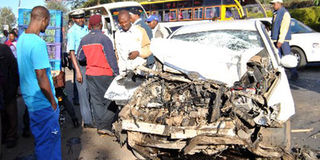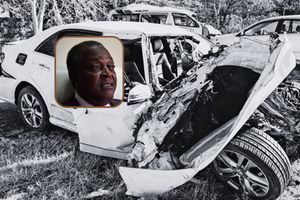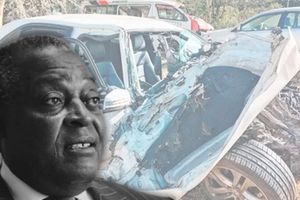Premium
3,130 dead and counting: The worst year on our roads

Three people were seriously injured when their vehicle was involved in an accident with a bus on Ngong Road, Nairobi, on December 28 2013. Latest statistics show that 13,028 people have been involved in road accidents since January 2013. PHOTO | ANTHONY OMUYA
What you need to know:
- Latest statistics show 13,028 people have been involved in road accidents since January
- The accidents also have far-reaching effects on the economy, but the government only resorts to knee-jerk solutions such as cancelling licences of vehicles involved in the accident
- On November, 12 people died at Nairobi’s Mutindwa area, even before the country could recover from the Ntulele accident along the Nairobi-Narok road on October, which claimed 41 lives
All they wanted was to celebrate Christmas with their loved ones upcountry. Instead, 18 ended up in morgues and 67 in hospital beds with serious injuries. About 12 were lucky to escape with minor injuries.
This happened on Christmas eve when “Horizon” and “Springs” buses collided at 3a.m. at Mtito Andei, on the Nairobi-Mombasa highway.
But in a country where death traps are licensed to operate as Public Service Vehicles (PSVs), accidents on our roads hardly surprise anyone.
For starters, once you board a PSV – especially the long distance ones – you cannot tell what could kill you. From speeding to unqualified, incompetent drivers to reckless driving, drunk driving, defective vehicles, fatigue, overloading, the list is endless.
Police data released last week paints a picture of a people with a knack for breaking traffic rules – and causing deaths.
“We have sunk to our worst in terms of number of accidents and deaths,” says a worried National Transport and Safety Authority (NTSA) board chairman Lee Kinyanjui.
By Boxing Day, 3,130 lives had been lost in accidents compared to 2,544, last year, making this one of the deadliest years on Kenyan roads. And yet, every major road accident has been followed by public outrage and calls for crackdown on reckless drivers.
Latest statistics show 13,028 people have been involved in road accidents since January.
According to Mr Cosmas Ngeso, the head of road safety department at NTSA, thousands of accident victims are left paralysed.
The accidents also have far-reaching effects on the economy, but the government only resorts to knee-jerk solutions such as cancelling licences of vehicles involved in the accident.
“The annual average cost of road traffic crashes to Kenya’s economy is five per cent of the Gross Domestic Product – about Sh14 billion,” estimates Mr Ngeso.
Buses and minibuses are also emerging as the most prone to deadly accidents.
CHASSIS ELONGATION
In August, Nation editor Charles Onyango-Obbo, in a column titled If you didn’t know, Kenya’s most deadly hangman lives in a bus, argued: “When buses are involved in accidents, the statistics are grim.”
He added: “Greedy operators elongate the chassis (the frame) of buses to create room for more seats inside. That compromises the balance.”
On November, 12 people died at Nairobi’s Mutindwa area, even before the country could recover from the Ntulele accident along the Nairobi-Narok road on October, which claimed 41 lives.
In the Mutindwa incident, the driver is said to have disregarded a stop order by a traffic police officer to give way to the morning train whereas in Ntulele accident, the driver is said to have fallen asleep while driving.
On October 24, 10 people died 200 metres from Ntulele when the driver of a station wagon lost control as he accelerated downhill and crashed into a matatu-- which was also in high speed.
In February, 35 people perished in a dawn accident in Mwingi after the driver of a Garissa-bound bus lost control and it veered off the road and crashed-- the bus was overloaded.
Traffic Police Commandant Samuel Kimaru told Sunday Nation that speeding is the leading cause of accidents.
“Virtually all accidents revolve around speed. If the driver was not exceeding the limit for personal cars then he had tampered with the speed governors for PSVs,” he said.
Mr Kinyanjui also blames the accidents on carelessness such as drunk driving.
“We are retraining our drivers and all these things will be included in the syllabus,” Mr Kinyanjui made yet another promise.
LACK OF ROAD MAINTAINANCE
But Mr Eric Maiti, a matatu driver on the Meru-Nairobi route, says the state of the roads is not considered in the apportioning of the blame when accidents occur.
“You find that a road has two extremely narrow lanes either on a bridge or at a black spot. Potholes are also a major cause of accidents,” he says.
“Thousands of people died at the Nithi Bridge in Meru because of that but since the road was expanded and bumps erected, the accidents have decreased.”
Mr Kinyanjui agrees, saying they are conducting a road safety audit to identify dangerous roads.
“Like the contractor of the stretch between Uthiru and Muguga on Waiyaki Way did not have pedestrians in mind when he put that concrete to separate the road,” he says.
“Also Mombasa Road with all those lanes and no footbridges has become the leading killer road for pedestrians.”
Although the police use alcoblow, alcohol breatherlyzer, to help nail drunk drivers, there’s little hope the carnage will stop. Most of those caught contravening the law will willingly bribes police officers not to test their level of drunkenness.
POLICE VETTING
Early December, police said they had raised Sh1 billion in fines from traffic offenders. Analysts say the amount could have been ten times higher, given the undocumented but high number of motorists who bribe their way out of trouble with the law.
Mr Kinyanjui says all officers who have stayed at a station for at least two years will be moved while the ongoing police vetting will kick out the corrupt ones.
He laid part of the blame on dishonesty in the force. He said the so-called Michuki rules succeeded because of strict enforcement.
“It’s a challenge. Most of these Proboxes are owned by police officers who know before hand when we are about to launch a crackdown,” said Mr Kinyanjui.
He also said the motor inspection unit will be privatised, speed cameras and electronic driving licenses introduced to ensure professionalism.





